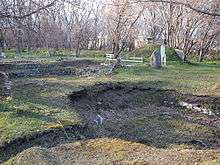Okhotsk culture

The Okhotsk culture is an archaeological coastal fishing and hunter-gatherer culture of the lands surrounding the Sea of Okhotsk (600–1000 CE in Hokkaido, until 1500 or 1600 CE in the Kurils): the Amur River basin, Sakhalin, northern Hokkaido, the Kuril Islands, and Kamchatka. It appears to have spread outwards from the Amur River region, only to be partially absorbed or pushed back by the Satsumon culture spreading north from Japan, but nevertheless surviving, for example, in the Nivkh of Sakhalin and the Amur and in Itelmen of Kamchatka. The historical Ainu people appear to have retained a strong element of the Okhotsk, but the Satsumon culture, and perhaps language, appears to have dominated the mix of people who contemporaneously became known as the Ainu.[1] Fundamental Okhotsk elements remained, however, such as the bear cult.[2]
Kisao Ishizuki of the Sapporo University claimed that the people of the Okhotsk culture was recorded under the name Mishihase on the Japanese record Nihon Shoki.[3]
References
- ↑ Sato, Takehiro; Amano, Tetsuya. "Origins and genetic features of the Okhotsk people, revealed by ancient mitochondrial DNA analysis". Springer (journal). doi:10.1007/s10038-007-0164-z.
- ↑ O. Harrassowitz (2007) "Journal of Asian History, Volume 41", p. 134-135
- ↑ "第4回 北海道と胆振地方の古代史" (in Japanese). Tomakomai Komazawa University. Retrieved February 22, 2011.
External links
- Ohyi, Haruo (1975). "The Okhotsk Culture, a Maritime Culture of the Southern Okhotsk Sea Region". In Fitzhugh, William. Prehistoric Maritime Adaptations of the Circumpolar Zone. pp. 123–58. doi:10.1515/9783110880441.123. ISBN 978-3-11-088044-1.
- Sato, Takehiro; Amano, Tetsuya; Ono, Hiroko; Ishida, Hajime; Kodera, Haruto; Matsumura, Hirofumi; Yoneda, Minoru; Masuda, Ryuichi (2007). "Origins and genetic features of the Okhotsk people, revealed by ancient mitochondrial DNA analysis". Journal of Human Genetics. 52 (7): 618–27. doi:10.1007/s10038-007-0164-z. PMID 17568987.
- Okada, Atsuko (1998). "Maritime Adaptations in Hokkaido". Arctic Anthropology. 35 (1): 340–9. JSTOR 40316474.